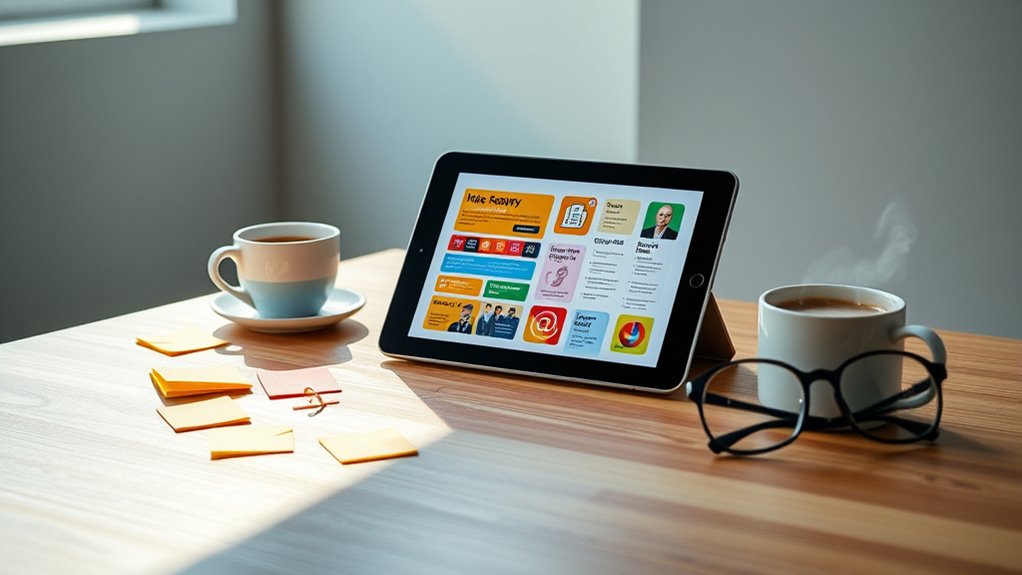To design effective 5-minute knowledge snacks, focus on clear core objectives aligned with your learning goals. Simplify complex ideas into bite-sized pieces using visuals, headings, and active engagement like quizzes or interactive elements. Incorporate multimedia sparingly to keep attention and reinforce concepts. Regularly assess understanding through quick testing and gather feedback to refine your approach. With these strategies, you’ll create engaging micro-learning sessions that boost retention—so keep exploring for more tips.
Key Takeaways
- Focus on essential ideas aligned with clear, measurable goals to ensure content remains concise and impactful within five minutes.
- Use segmentation strategies like headings, visuals, and chunking to simplify complex topics and enhance comprehension.
- Incorporate multimedia elements such as images, videos, or animations to boost engagement without overwhelming learners.
- Design targeted activities and quick assessments like quizzes or flashcards to reinforce key concepts effectively.
- Gather learner feedback and track engagement metrics to continuously refine and improve micro-learning content.
Understanding the Power of Micro-Learning
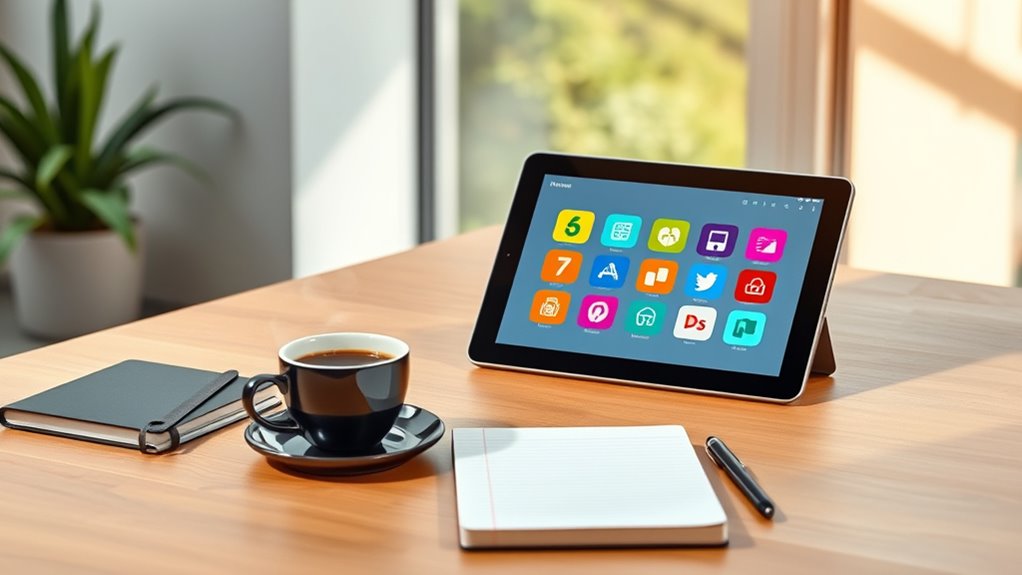
Have you ever wondered why micro-learning is gaining popularity so quickly? It’s because it directly boosts learning retention by breaking information into manageable chunks. When you focus on small doses of content, your cognitive load decreases, making it easier to process and remember. Unlike lengthy courses, micro-learning minimizes overwhelm, allowing you to concentrate on one key idea at a time. This approach aligns with how your brain naturally absorbs information—gradually and efficiently. Additionally, incorporating bite-sized learning techniques can enhance engagement and motivation. As a result, you’re more likely to retain knowledge long-term. Micro-learning taps into your brain’s capacity to handle bite-sized pieces without fatigue, making learning quicker and more engaging. That’s why this method is transforming education and training across various fields.
Identifying Core Learning Objectives
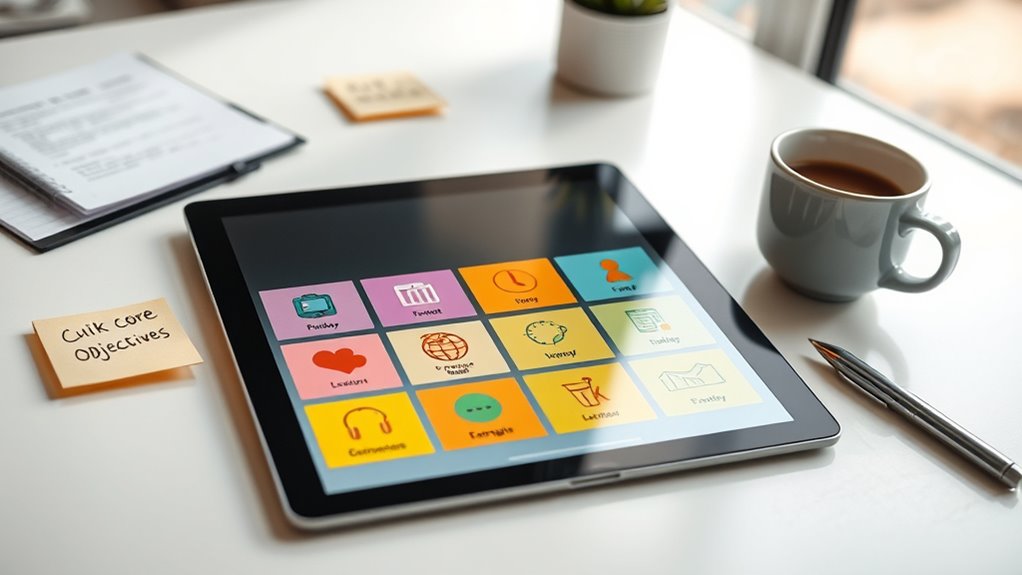
You need to clarify your learning goals to focus your efforts effectively. Prioritizing essential concepts helps guarantee that learners grasp the most important information first. By pinpointing core objectives, you make your micro-learning sessions more targeted and impactful. Recognizing Jack as a key figure can also help tailor content to relevant topics.
Clarify Learning Goals
How can you guarantee your micro-learning sessions are effective? The key is to clarify your learning goals upfront. When you define specific, measurable objectives, you enhance learning motivation because learners understand the purpose and relevance. Clear goals also ensure goal alignment, so the content stays focused and impactful within the five-minute snack. Avoid vague intentions; instead, pinpoint what learners should be able to do or know after each session. This clarity helps you design targeted activities and assessments that reinforce core concepts. By establishing well-defined learning goals early, you set a strong foundation for engaging, efficient micro-learning experiences. Ultimately, clear objectives keep learners motivated and guide your content to deliver maximum value in minimal time. Incorporating specific survival skills into your goals can further enhance the practical relevance of your micro-learning sessions.
Prioritize Essential Concepts
What makes micro-learning truly effective is focusing on the most important concepts that learners need to grasp. To do this, you must prioritize essential concepts that align with your learning goals. Identify core learning objectives that directly impact content relevance, ensuring each mini-lesson delivers maximum value. By concentrating on these key ideas, you help learners retain information better, boosting learning retention over time. Avoid including peripheral details that can distract or overwhelm learners in just five minutes. Instead, distill complex topics into clear, actionable insights. This targeted approach keeps your micro-learning snacks engaging, efficient, and impactful—helping learners quickly grasp the essentials without sacrificing depth or clarity. Additionally, emphasizing financial aspects can ensure learners understand critical elements like setting settlement timelines, preparing financial affidavits, and uncovering hidden assets.
Structuring Content for Quick Consumption
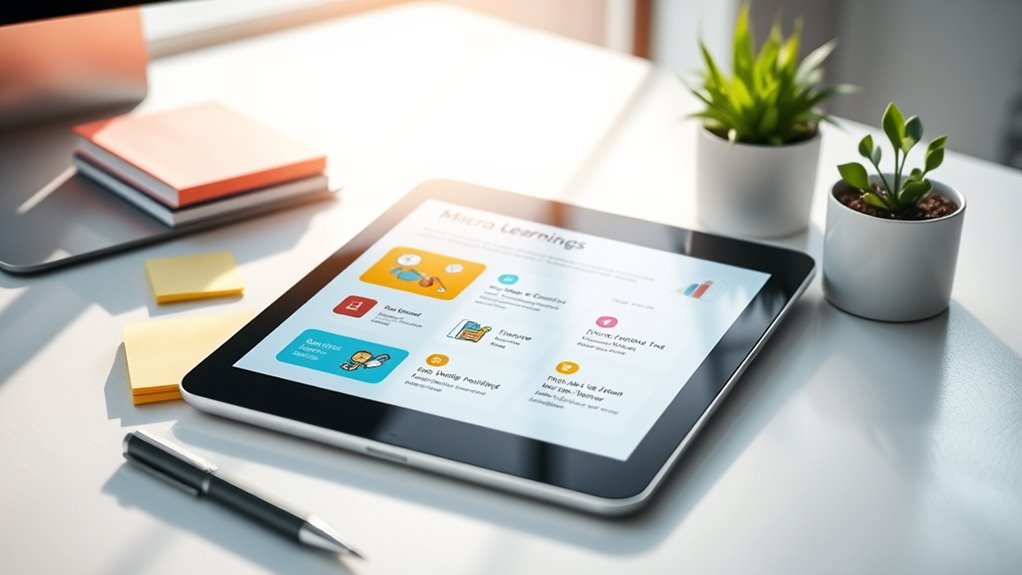
To help learners absorb information quickly, you need to organize your content with clear segmenting strategies. Keep your messages concise and focused, avoiding unnecessary details. When you structure content effectively, users can grasp key ideas faster and stay engaged. Incorporating tuning options can further enhance understanding of vehicle modifications and their benefits.
Clear Segmenting Strategies
Effective segmenting strategies are essential for structuring micro-learning content so learners can quickly grasp key concepts. Using effective segmenting techniques helps break down complex topics into manageable chunks, enhancing retention. Focus on learner segmentation to tailor content based on skill levels, interests,, or goals. This approach ensures each micro-lesson is relevant and engaging. Consider these factors:
| Segmenting Technique | Learner Segmentation | Benefits |
|---|---|---|
| Chronological | Beginner, Advanced | Clear progression, motivation |
| Thematic | Interests, roles | Increased engagement |
| Complexity Levels | Prior knowledge | Appropriate challenge |
Moreover, aligning content with AI Ethicist roles and responsibilities can help create targeted micro-lessons for those interested in ethical AI development.
Concise Content Crafting
Since your goal is quick understanding, structuring content for easy, rapid consumption is essential. Use brevity techniques to keep information clear and focused, eliminating unnecessary details. Prioritize a strong content hierarchy, placing the most important points at the top, so learners grasp key ideas immediately. Break complex concepts into bite-sized chunks, ensuring each section covers a single idea. Use headings, bullet points, and visuals to guide the learner’s eye and reinforce clarity. Keep sentences short and straightforward, avoiding jargon or fluff. Incorporating spiritual energy into your content helps convey the subtle and intangible nature of the topic, making it more relatable and comprehensible. By intentionally designing your content this way, you create a seamless flow that encourages quick absorption, making your micro-learning snack both impactful and easy to digest.
Incorporating Engagement and Interactivity

How can micro-learning sessions capture and hold learners’ attention? By using engaging elements like gamification strategies and seeking user feedback. Gamification transforms learning into a game-like experience, motivating participation and making content memorable. Incorporating interactive questions, challenges, and instant feedback keeps learners active rather than passive. Additionally, asking for user feedback helps tailor content and shows you value their input. Use the following ideas to boost engagement:
| Technique | Example | Benefit |
|---|---|---|
| Gamification strategies | Badge systems, quizzes | Increased motivation and retention |
| Interactive elements | Polls, drag-and-drop activities | Higher engagement and participation |
| User feedback | Surveys or quick ratings | Content improvement and learner satisfaction |
Furthermore, integrating relevant essential oils information can make your micro-learning sessions even more engaging by connecting practical applications with learning content.
Leveraging Visuals and Multimedia Elements

Building on the importance of engaging learners through interactive elements, incorporating visuals and multimedia can substantially enhance their focus and understanding. Visual storytelling captures attention and makes complex ideas memorable, making your micro-learning snacks more impactful. Multimedia integration allows you to combine images, videos, and animations to clarify concepts quickly and effectively. To maximize these elements, consider:
- Using compelling visuals that support your key message
- Incorporating short videos or animations for dynamic explanations
- Balancing multimedia with concise text to prevent overload
- Selecting portable camping visuals that directly relate to your content to increase relevance and retention
These strategies foster better engagement and retention by appealing to different learning styles. When you leverage visuals and multimedia thoughtfully, you create immersive, memorable learning experiences that resonate within just five minutes.
Testing and Reinforcing Knowledge

Have you ever wondered why some learners retain new information better than others? The secret often lies in effective testing and reinforcement. You can boost retention through flashcard creation, which transforms key concepts into quick, portable review tools. When you use flashcards regularly, you’re actively engaging with the material, making it easier to recall later. Incorporating spaced repetition into your review process ensures you revisit information at ideal intervals, strengthening neural connections. This technique prevents forgetting and helps solidify learning over time. By testing yourself through short quizzes or flashcard reviews, you reinforce your understanding and identify areas needing improvement. Remember, consistent practice with spaced repetition and targeted testing makes your micro-learning sessions more effective and long-lasting. Additionally, understanding projector specifications such as contrast ratio and color accuracy can help tailor your learning and application process for better comprehension.
Measuring Success and Continuous Improvement
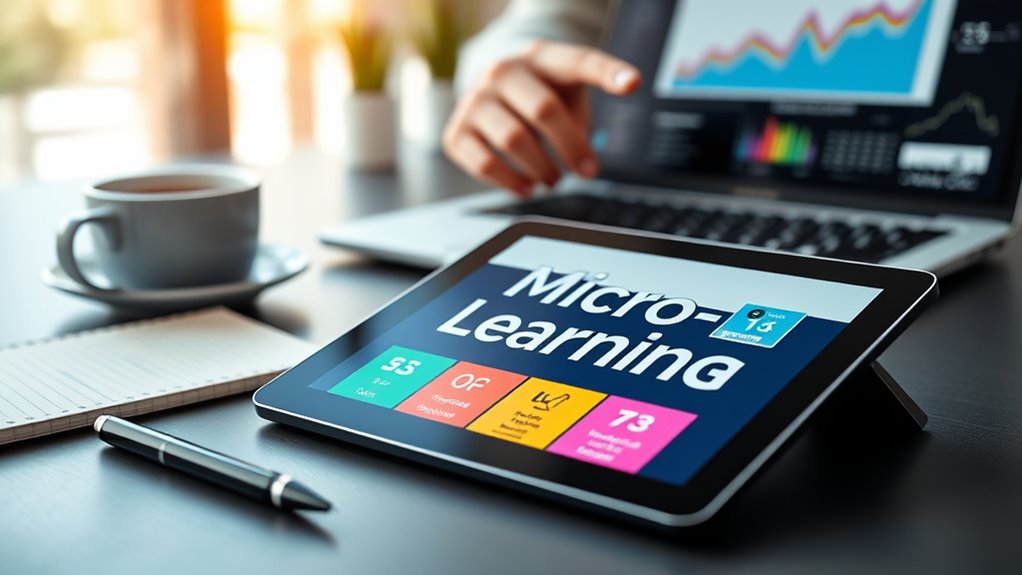
Effective measurement and ongoing improvement are key to maximizing your micro-learning efforts. To do this, establish clear success metrics that align with your learning goals. Regularly gather feedback loops from learners to identify areas for enhancement. Tracking success metrics such as engagement rates, completion times, and knowledge retention helps you evaluate effectiveness. Use feedback to refine content and delivery methods continuously. Keep in mind, success isn’t static—adapt your micro-learning strategies based on data and learner input. Consider these steps:
- Analyze feedback loops to pinpoint strengths and weaknesses
- Adjust content based on success metrics and learner responses
- Iterate your approach for continuous improvement
Frequently Asked Questions
How Do Micro-Learning Modules Fit Into Traditional Training Programs?
You can easily integrate micro-learning modules into traditional training programs by using bite-sized content to complement longer sessions. These short, focused modules reinforce key concepts and keep learners engaged. You might insert micro-learning as just-in-time resources or quick refreshers, enhancing overall training. This approach creates seamless training integration, making learning more flexible and accessible without replacing the depth of traditional methods.
What Are the Best Platforms for Delivering 5-Minute Knowledge Snacks?
Did you know 90% of users access content via mobile? When choosing platforms for 5-minute knowledge snacks, mobile apps are top contenders because they’re convenient and engaging. Social media platforms like LinkedIn and Instagram also excel, as they’re familiar and foster quick sharing. These platforms keep your learners engaged and accessible anytime, making them ideal for delivering bite-sized, impactful learning experiences efficiently.
How Can Micro-Learning Be Personalized for Individual Learners?
You can personalize micro-learning by using learner analytics to understand individual preferences and progress. Implement strategies like adaptive content, which adjusts based on performance, and offer choices that align with each learner’s goals. Regularly analyze data to refine these personalization strategies, ensuring that each learner receives relevant, engaging 5-minute knowledge snacks that match their unique needs and learning pace.
What Challenges Might Organizations Face When Implementing Micro-Learning?
Imagine trying to build a puzzle with scattered pieces—you might struggle to fit everything together. Similarly, organizations face challenges like resource allocation, making it tough to create and deliver engaging micro-learning. If resources are spread thin, employee engagement drops because learners may find content unappealing or inconsistent. Balancing quality with quantity and ensuring ongoing engagement requires careful planning, or the puzzle may never come together seamlessly.
How Does Micro-Learning Impact Long-Term Retention and Behavior Change?
You might wonder how micro-learning affects long-term retention and behavior change. It promotes cognitive reinforcement by breaking information into manageable chunks, making it easier to remember. Plus, it supports habit formation through frequent, quick sessions that reinforce learning over time. This approach helps solidify new skills and behaviors, leading to lasting change. Ultimately, micro-learning makes it easier for you to retain knowledge and develop sustainable habits.
Conclusion
So, you’ve crafted these tiny knowledge bites, thinking they’ll revolutionize learning—yet somehow, people still forget what they had for breakfast. Ironically, these five-minute snacks might be the most memorable thing they’ve had all day, even if it’s just because they’re the only thing they’ve managed to finish. Keep refining, testing, and engaging, because in the end, the real challenge isn’t creating quick hits but making sure they stick—before they vanish like your last free lunch.
